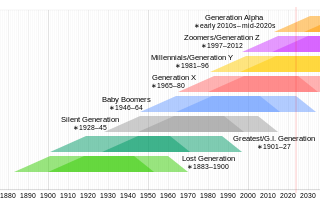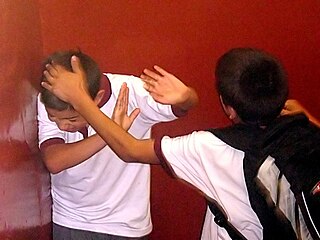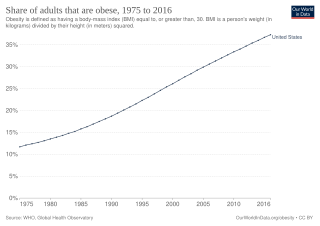Related Research Articles

Generation X is the demographic cohort following the Baby Boomers and preceding Millennials. Researchers and popular media often use the mid-1960s as its starting birth years and the late 1970s as its ending birth years, with the generation being generally defined as people born from 1965 to 1980. By this definition and U.S. Census data, there are 65.2 million Gen Xers in the United States as of 2019. Most of Generation X are the children of the Silent Generation and early Baby Boomers; Xers are also often the parents of Millennials and Generation Z.
The British Academy of Film and Television Arts is an independent trade association and charity that supports, develops, and promotes the arts of film, television and video games in the United Kingdom. In addition to its annual award ceremonies, BAFTA has an international programme of learning events and initiatives offering access to talent through workshops, masterclasses, scholarships, lectures, and mentoring schemes in the United Kingdom and the United States.

A boy is a young male human. The term is commonly used for a child or an adolescent. When a male human reaches adulthood, he is usually described as a man.

Youth is the time of life when one is young. The word, youth, can also mean the time between childhood and adulthood (maturity), but it can also refer to one's peak, in terms of health or the period of life known as being a young adult. Youth is also defined as "the appearance, freshness, vigor, spirit, etc., characteristic of one, who is young". Its definitions of a specific age range varies, as youth is not defined chronologically as a stage that can be tied to specific age ranges; nor can its end point be linked to specific activities, such as taking unpaid work, or having sexual relations.

Bullying is the use of force, coercion, hurtful teasing or threat, to abuse, aggressively dominate or intimidate. The behavior is often repeated and habitual. One essential prerequisite is the perception of an imbalance of physical or social power. This imbalance distinguishes bullying from conflict. Bullying is a subcategory of aggressive behavior characterized by hostile intent, imbalance of power and repetition over a period of time.
A longitudinal study is a research design that involves repeated observations of the same variables over long periods of time. It is often a type of observational study, although it can also be structured as longitudinal randomized experiment.
School violence includes violence between school students as well as attacks by students on school staff and attacks by school staff on students. It encompasses physical violence, including student-on-student fighting, corporal punishment; psychological violence such as verbal abuse, and sexual violence, including rape and sexual harassment. It includes many forms of bullying and carrying weapons to school. The one or more perpetrators typically have more physical, social, and/or psychological power than the victim. It is a widely accepted serious societal problem in recent decades in many countries, especially where weapons such as guns or knives are involved.
Relational aggression, alternative aggression, or relational bullying is a type of aggression in which harm is caused by damaging someone's relationships or social status.

Generation Z, colloquially known as Zoomers, is the demographic cohort succeeding Millennials and preceding Generation Alpha. Researchers and popular media use the mid-to-late 1990s as starting birth years and the early 2010s as ending birth years. Most members of Generation Z are the children of Generation X or older Millennials.
The Dunedin Multidisciplinary Health and Development Study is a detailed study of human health, development and behaviour. Based at the University of Otago in New Zealand, the Dunedin Study has followed the lives of 1037 babies born between 1 April 1972 and 31 March 1973 at Dunedin's former Queen Mary Maternity Centre since their birth. Teams of national and international collaborators work on the Dunedin Study, including a team at Duke University in the United States. The research is constantly evolving to encompass research made possible by new technology and seeks to answer questions about how people's early years have an impact on mental and physical health as they age.

School bullying, like bullying outside the school context, refers to one or more perpetrators who have greater physical strength or more social power than their victim and who repeatedly act aggressively toward their victim. Bullying can be verbal or physical. Bullying, with its ongoing character, is distinct from one-off types of peer conflict. Different types of school bullying include ongoing physical, emotional, and/or verbal aggression. Cyberbullying and sexual bullying are also types of bullying. Bullying even exists in higher education. There are warning signs that suggest that a child is being bullied, a child is acting as a bully, or a child has witnessed bullying at school.

Obesity is common in the United States and is a major health issue associated with numerous diseases, specifically an increased risk of certain types of cancer, coronary artery disease, type 2 diabetes, stroke, and cardiovascular disease, as well as significant increases in early mortality and economic costs.

Physical or corporal punishment by a parent or other legal guardian is any act causing deliberate physical pain or discomfort to a minor child in response to some undesired behavior. It typically takes the form of spanking or slapping the child with an open hand or striking with an implement such as a belt, slipper, cane, hairbrush or paddle, whip, hanger, and can also include shaking, pinching, forced ingestion of substances, or forcing children to stay in uncomfortable positions.
Disability abuse is when a person with a disability is abused physically, financially, sexually and/or psychologically due to the person having a disability. This type of abuse has also been considered a hate crime. The abuse is not limited to those who are visibly disabled or physically deformed, but also includes those with learning, intellectual and developmental disabilities or mental illnesses.

The Avon Longitudinal Study of Parents and Children (ALSPAC), also known as Children of the 90s and formerly the Avon Longitudinal Study of Pregnancy and Childhood, is a cohort study of children born in the former county of Avon, England during 1991 and 1992. It is used by researchers in health, education and other social science disciplines.
Various researchers have undertaken efforts to examine the psychological effects of Internet use. Some research employs studying brain functions in Internet users. Some studies assert that these changes are harmful, while others argue that asserted changes are beneficial.
Bullying suicide are considered together when the cause of suicide is attributable to the victim having been bullied, either in person or via social media. Writers Neil Marr and Tim Field wrote about it in their 2001 book Bullycide: Death at Playtime.
Cyberbullying or cyberharassment is a form of bullying or harassment using electronic means. Cyberbullying and cyberharassment are also known as online bullying. It has become increasingly common, especially among teenagers and adolescents, due to the communication technology advancements and young people's increased use of such technologies. Cyberbullying is when someone, typically a teenager, bullies or harasses others on the internet and other digital spaces, particularly on social media sites.
Since their inception in the 1970s, video games have often been criticized by some for violent content. Politicians, parents, and other activists have claimed that violence in video games can be tied to violent behavior, particularly in children, and have sought ways to regulate the sale of video games. Studies have shown no connection between video games and violent behavior. The American Psychological Association states that while there is a well-established link between violent video games and aggressive behaviors, attributing acts of violence to violent video gaming "is not scientifically sound."
The relationships between digital media use and mental health have been investigated by various researchers—predominantly psychologists, sociologists, anthropologists, and medical experts—especially since the mid-1990s, after the growth of the World Wide Web. A significant body of research has explored "overuse" phenomena, commonly known as "digital addictions", or "digital dependencies." These phenomena manifest differently in many societies and cultures. Some experts have investigated the benefits of moderate digital media use in various domains, including in mental health, and the treatment of mental health problems with novel technological solutions.
References
- ↑ "Bullying's Long-Term Effects Seen in Both the Bullied and the Bully". News.nationalgeographic.com. Archived from the original on May 16, 2014. Retrieved October 8, 2015.
- ↑ "Duke Developmental Epidemiology Program". Devepi.duhs.duke.edu. Retrieved October 8, 2015.
- 1 2 3 "The remarkable thing that happens to poor kids when you give their parents a little money". The Washington Post. Retrieved October 8, 2015.